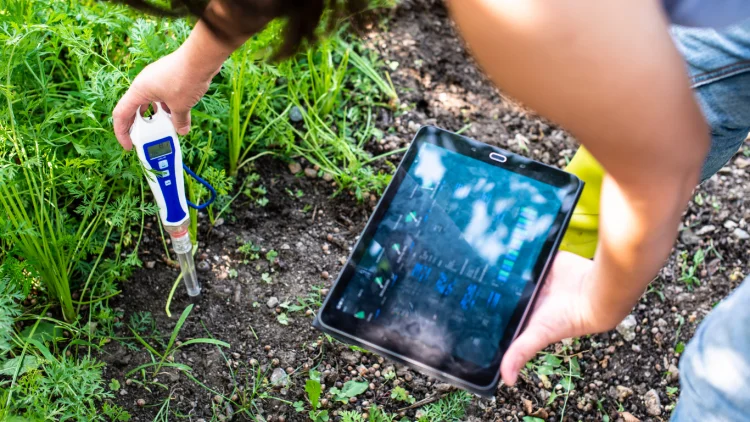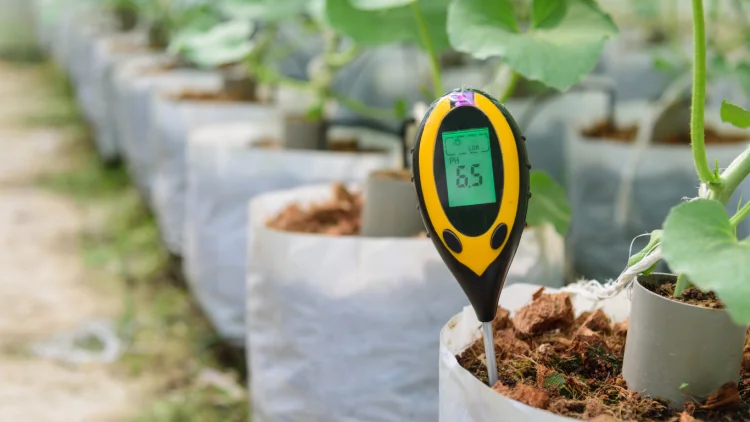Alkaline soil pH correction is crucial for improving soil fertility, ensuring proper plant growth, and maintaining a healthy soil environment.
Soil pH is a measure of acidity or alkalinity, ranging from 0 to 14. Various soil test kits are available on the market to measure hydrogen ion concentration in soil solution, providing an accurate picture of your soil’s condition.
At a pH of 7.0, the soil is considered neutral. A lower pH indicates acidic soil, with increasing acidity as the number decreases. Conversely, a higher pH means alkaline soil, with alkalinity increasing as the value rises.
The pH scale is logarithmic, meaning that a one-unit change represents a tenfold difference in acidity or alkalinity, which explains why alkaline soil pH correction takes time and requires careful management.
When is soil considered alkaline?
Soil is classified as alkaline when it contains high levels of calcium (calcareous soil). Additionally, using alkaline irrigation water can gradually increase soil alkalinity—though this can be corrected with proper soil management.
Generally, calcareous soils form from parent materials rich in calcium carbonate. Under dry or semi-arid conditions, they accumulate carbonate salts in the upper soil layers. This type of soil is common in Mediterranean regions and requires special attention when correcting alkaline soil pH.
Early detection and proper pH adjustment in alkaline soils can prevent serious plant nutrition problems before they appear.
What issues does high pH cause in alkaline soils?
The main issue with high pH is reduced nutrient availability, which leads to deficiencies and poor plant development. Phosphorus, in particular, becomes less available in alkaline soils, as it binds with calcium and settles deeper in the soil profile.
Timely alkaline soil pH correction helps restore nutrient balance and improve plant uptake efficiency. To accurately diagnose the problem, it is essential to send a soil sample for analysis to a specialized laboratory. This will help determine the right strategy for alkaline soil pH correction tailored to your field’s specific needs.
If you want to better understand how soil pH affects fertility and crop productivity, read our related article: “Soil pH and its importance for fertility and crop growth.”
What are the most effective methods for alkaline soil pH correction
Several techniques and materials can be applied effectively for alkaline soil pH correction. Below are the most reliable and widely used methods.
Use of chelated fertilizers
Chelated fertilizers increase the availability of micronutrients that plants struggle to absorb in alkaline conditions. However, be cautious with phosphate fertilizers, as excessive use can reduce the availability of other essential elements.
Application of sulfur
Adding sulfur is one of the most effective methods for correcting alkaline soil pH. Lowering soil pH to the desired range (6.2–7.3) can be achieved by applying powdered sulfur before planting or seeding.
Iron or aluminum compounds may also be used, as they release hydrogen ions when reacting with water. Regular sulfur applications are among the most reliable practices for correcting alkaline soil pH, particularly in areas with high calcium content.
Addition of organic matter
Incorporating organic amendments, such as compost made from acidic materials (e.g., pine needles), helps naturally acidify the soil. As microorganisms break down organic matter, they release carbon dioxide (CO₂), which forms carbonic acid, gradually lowering soil pH.
Use of ammonium sulphate fertilizer
Ammonium sulfate is an acidic fertilizer that gradually lowers soil pH. As soil bacteria convert ammonium to nitrate, they produce hydrogen ions, which naturally reduce alkalinity and improve nutrient absorption.
Planting alkaline-tolerant species
Some plant species can tolerate or even thrive in soils with a pH between 7.0 and 8.0. Selecting alkaline-tolerant crops or ornamentals is a practical and sustainable solution, especially when chemical pH correction is slow or difficult.
Conclusion
Calcareous soils, which are naturally alkaline rather than the result of improper farming practices, are difficult to modify.
Effective alkaline soil pH correction requires patience, consistency, and professional agronomic guidance.
To achieve a more balanced soil environment, it is essential to:
- Conduct a reliable soil pH analysis through a certified laboratory.
- Seek expert agronomic advice regarding the type and dosage of materials to be applied.
With continuous monitoring, proper alkaline soil pH correction, and expert supervision, you can maintain a productive and well-balanced soil for many years.


